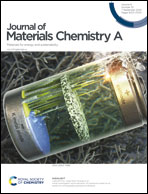Investigation of Rh–titanate (ATiO3) interactions on high-surface-area perovskite thin films prepared by atomic layer deposition†
Abstract
Thin, ∼1 nm films of CaTiO3, SrTiO3, and BaTiO3 were deposited onto MgAl2O4 by Atomic Layer Deposition (ALD) and studied as catalyst supports for Rh. Scanning Transmission Electron Microcopy (STEM) and X-Ray Diffraction (XRD) demonstrated that the films had the perovskite structure and formed uniform coatings stable up to 1073 K. Rh, added by ALD, interacted strongly with CaTiO3 and somewhat less strongly with SrTiO3, while Rh on BaTiO3 was similar to Rh on unmodified MgAl2O4. STEM measurements of Rh on CaTiO3 films showed Rh remained well dispersed after repeated oxidations and reductions at 1073 K; however, the Rh was inactive for CO-oxidation. Rh formed small particles on SrTiO3 films and was active for CO oxidation after reduction at 1073 K. The reducibility and catalytic activity of Rh/BaTiO3/MgAl2O4 were similar to that of Rh/MgAl2O4. Evidence from CO-TPR, FTIR, and XPS all indicated that the degree of interaction between Rh and the three perovskite films can be ranked in the following order: Rh/CaTiO3/MgAl2O4 > Rh/SrTiO3/MgAl2O4 > Rh/BaTiO3/MgAl2O4. Bulk ex-solution catalysts, synthesized by reduction of ATi0.98Rh0.02O3 (A = Ca, Sr, and Ba), were also examined for comparison.



 Please wait while we load your content...
Please wait while we load your content...
